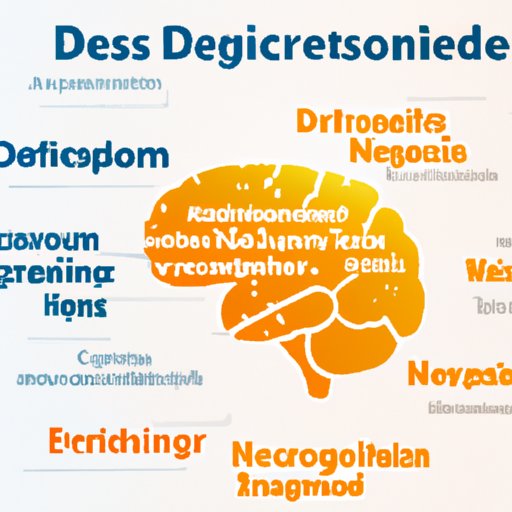Introduction
A neurological disorder is an illness that affects the functioning of the brain, spinal cord or other parts of the nervous system. These disorders can range from mild to severe, and can affect people of all ages. In this article, we will be exploring the most common neurological disorder, looking at its prevalence, symptoms, treatments, risk factors, quality of life impacts, causes, consequences and latest research and developments.

Exploring the Prevalence of the Most Common Neurological Disorder
The most common neurological disorder is epilepsy, which is a chronic neurological condition characterized by recurrent seizures. According to the World Health Organization (WHO), approximately 50 million people worldwide have epilepsy, making it one of the most common neurological disorders. In the United States alone, around 3 million people have been diagnosed with epilepsy. Prevalence rates vary across different regions and countries, but overall, the disorder is estimated to affect between 0.5-1% of the population.
Examining trends and changes over time can also provide insight into the prevalence of the disorder. Studies have found that the prevalence of epilepsy has remained relatively stable over the past few decades, although there has been an increase in the number of cases reported in some countries due to improved diagnosis and access to healthcare services.
An Overview of the Symptoms and Treatment for the Most Common Neurological Disorder
The symptoms of epilepsy vary depending on the type of seizure experienced. Generally, seizures involve a sudden change in behavior, such as loss of consciousness, muscle spasms or confusion. Other symptoms may include loss of bladder control, jerking movements, staring spells and strange sensations. Seizures can last anywhere from a few seconds to several minutes.
Treatment for epilepsy typically involves medication, lifestyle changes and/or surgery. The goal of treatment is to reduce the frequency and severity of seizures, and to improve the patient’s quality of life. Medications are usually the first line of treatment, and can help control seizures in up to 70% of patients. Surgery is recommended for people whose seizures are not controlled by medications, and may involve removing part of the brain that is causing the seizures.

Examining the Risk Factors Associated with the Most Common Neurological Disorder
There are several risk factors associated with epilepsy that can increase a person’s chances of developing the disorder. These include lifestyle factors such as smoking, alcohol use, drug use and head injuries. Environmental factors such as exposure to toxins or certain infections can also increase the risk of developing epilepsy.
In addition, certain genetic and hereditary factors have been linked to an increased risk of developing the disorder. Studies have found that having a family history of epilepsy can increase the risk of developing the disorder by up to 20%. However, it is important to note that most people with a family history of epilepsy will never develop the disorder themselves.
Investigating the Impact of the Most Common Neurological Disorder on Quality of Life
Living with epilepsy can have a significant impact on a person’s quality of life. People with the disorder may experience physical, mental and emotional effects, such as fatigue, difficulty concentrating, depression and anxiety. Seizures can also lead to social isolation, as people may be reluctant to participate in activities or socialize with others due to fear of having a seizure.
In addition, people with epilepsy may experience financial difficulties due to the costs associated with medications and treatments. They may also struggle to find and maintain employment due to their condition.

Understanding the Causes and Consequences of the Most Common Neurological Disorder
The exact cause of epilepsy is still unknown, although there are several potential factors that may play a role. Genetics and heredity appear to be primary causes, but environmental factors such as exposure to toxins, certain infections and head injuries may also contribute. It is believed that these factors can trigger changes in the brain that lead to seizures.
Epilepsy can have serious consequences if it is not properly managed. Seizures can lead to injury, accidents and even death in some cases. In addition, the disorder can affect a person’s ability to work and engage in everyday activities, leading to social isolation and depression.
Evaluating the Latest Research and Developments in the Most Common Neurological Disorder
Research into epilepsy is ongoing, with new medications and therapies being developed to treat the disorder. Several new medications have been approved in recent years, and there is ongoing research into novel therapies such as deep brain stimulation and gene therapy. In addition, researchers are studying new ways to diagnose and monitor the disorder, as well as examining potential causes and risk factors.
Overall, there is a great deal of research being conducted into the most common neurological disorder, and new developments are being made all the time. As more is learned about the condition, it is hoped that better treatments and therapies can be developed to improve the lives of those living with epilepsy.
Conclusion
Epilepsy is one of the most common neurological disorders, affecting millions of people worldwide. The disorder is characterized by recurrent seizures, and can have a significant impact on a person’s quality of life. While the exact cause of epilepsy is still unknown, there are several potential risk factors that can increase the risk of developing the disorder. Treatment typically involves medications, lifestyle changes and/or surgery, and new treatments and therapies are constantly being developed.
In conclusion, understanding the most common neurological disorder is important in order to recognize the signs and symptoms, identify potential risk factors and explore available treatments. With continued research and developments, it is hoped that more effective treatments and therapies can be developed to improve the lives of those living with epilepsy.


